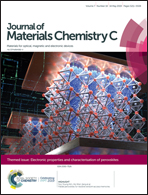The photomechanic effects of the molecular crystals based on 5-chloro-2-(naphthalenylvinyl)benzoxazols fueled by topo-photochemical reactions†
Abstract
The photo-reactive 5-chloro-2-(naphthalenylvinyl)benzo[d]oxazols (BOV1N, BOV1NF, BOV1NM, BOV2N, and BOV2NM) have been prepared. Interestingly, their molecular crystals exhibit significant photomechanic effects and the 1H NMR spectral changes for the microcrystals before and after UV irradiation suggest that photodimerization is the driving force for the light-induced macroscopic mechanic movements. The needle-like crystals of BOV1N bend away from the UV light upon irradiation for several seconds. Such rapid elastic deformation could be repeated several times. It should be noted that β-type and α-type cyclobutane derivatives D-BOV1N (the dimer of BOV1N) are afforded as the main product and byproduct, respectively, after the microcrystals were exposed to 365 nm light for 5 min. Since the photo-induced [2+2] cycloaddition shortens the distance of the olefin pairs and makes the terminal units stretch outside the molecular long axle, the strain in the phototropic surface of the crystal can be yielded and accumulated. The release of the accumulated strain leads to the bending of the needle-like crystals backwards to the UV light. Thus, it was reasonable that the thinner fibers exhibited more rapid and significant movements on account of the high topo-photochemical reaction efficiency. The molecular crystals of BOV1NF, BOV2N, and BOV2NM exhibited similar photomechanic effects. We also found that the UV irradiation parallel to the long axis of crystals would not drive the crystals to move. On the contrary, the light-induced slipping and swinging of the needle-like crystal of BOV1NM is observed due to the low dimerization efficiency. Thus, the molecular crystals based on the naphthylvinylbenzoxazole derivatives become new platforms for the efficient light-mechanical energy conversion.



 Please wait while we load your content...
Please wait while we load your content...